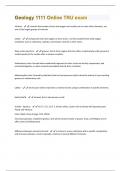Exam (elaborations)
Geology 1111 Online TRU Exam(100% correct and graded A+)
- Course
- Institution
silicates - minerals that contain silicon and oxygen and usually one or more other elements, are one of the largest groups of minerals oxides - compounds that have oxygen as their anion, t ut they exclude those with oxygen complexes such as carbonate, suphate, and silicate. have O2 as their anio...
[Show more]



